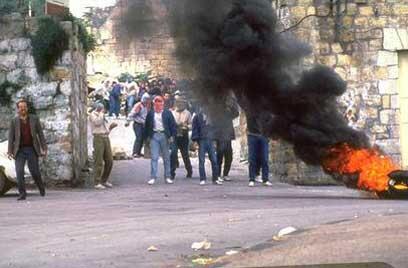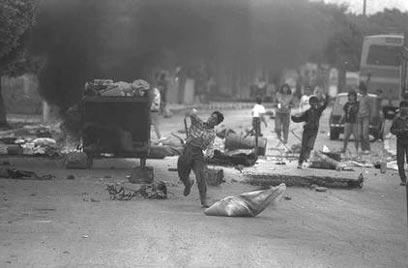Are we on the verge of a third intifada? Experts say probably not. After a "day of rage "in Jerusalem, it seems the spirits have calmed down, as riots subsided and have yet to spread into the West Bank.
Some leading figures who served in key positions during the first intifada inDecember 1987 agree that we are still far from another uprising. However, they say things might change according to future developments.
For instance, matters might get out of hand once there are serious casualties. "Until now, there was no force strong enough to bring incitement to a boiling point," said Brig.-Gen. (res.) Shalom Harari, who served as senior advisor on Palestinian affairs in the Defense Ministry in 1987.
"The reason for that," Harari added, "is the relative restraint of the police and its excellent alertness, which resulted in only minor injuries."
Ramallah, 1988 (Photo: GPO)
Currently a Senior Research Scholar with the Institute for Counter-Terrorism (ICT) at the Interdisciplinary Center in Herzliya, Harari said that the first intifada also began with sporadic riots, and became an organized uprising only after the first victims were brought to burial. This, Harari warned, might repeat itself once more: "The big test will be during Friday prayers at Temple Mount."
Lt. Colonel (Res.) Moshe Marzouk, formerly an advisor on Arab affairs for the army intelligence and currently a senior research fellow at the Institute for Counter-Terrorism, was head of an intelligence unit dealing with Palestinian issues during the break of the first intifada. Marzouk discarded comparisons between the latest events and the two former intifadas.
Nablus, 1988 (Photo: GPO)
"I wouldn't go as far as using such terms, which reminds us of the first intifada that started in a similar way – as a popular uprising – and expanded into a sweeping struggle that included all strata of society, in the Gaza Strip and the West Bank," Marzouk noted.
Palestinians divided
"The second intifada (al-Aqsa intifada )involved terror attacks in Jerusalem and was completely different. At the moment the Palestinians are divided, and there is no unity among east Jerusalem Arabs either – who during the former uprisings managed to entirely paralyze trade," he said.
Marzouk added that conditions on the ground have also changed: "Gaza is blockaded, and the Palestinian Authority is ruling the West Bank. On the other hand, there may well be more days of rage like today."
Marzouk noted that what will happen in the next few days is up to the Israeli government and law enforcement. "There is a storm, but it is still under control. The next days are critical, and have a lot to do with how Israel conducts its affairs. We need to pacify the area – which seems to be the healthiest solution."
Amram Mitzna became commander of the Central Command in May 1987 – approximately six months before the break of the intifada. "There is danger of a third uprising," he said, "although it is hard to say whether it will materialize."
Mitzna also noted that conditions have changed: "Palestinians in the West Bank are in dire economic situation, and the ones who are more settled and work will not take part, but will only give lip service."
"On the other hand, "Mitzna added, "the younger people on the streets will want to set things on fire with full force. So there seems to be two directions, and the outcome depends on where the wind blows."



